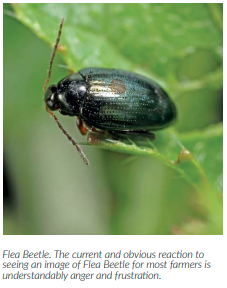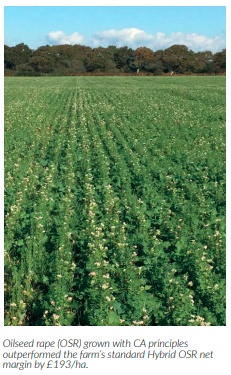Written by Richard Harding, Procam
In a year where recent events have triggered a rethink in many areas of our lives, one major question is where to get advice that aims to future-proof the farm business for the long term.
Having been involved with farms practicing conservation agriculture (CA) or regenerative agriculture (RA) for over 10 years, it has increasingly felt like there is a disconnect between what the farmer requires from an agronomist and what the existing agronomy model offers. As Mark Dewes, a recent Nuffield Scholar, wrote in his article for the last issue of Direct Driller, “out-sourcing of pesticide management to agronomists has contributed to a disengagement of farmers from their own agronomic decision making”. It also assumes a chemical is likely to be the primary solution. I would go further and say UK agriculture and wider society is obsessed with buying the solution to a problem rather than seeing themselves as being the solution.
One topical subject, for example, is Cabbage Stem Flea Beetle. How many farmers have you heard say “Flea Beetle is a real problem on my farm and there are no longer any reliable chemical solutions”? An alternative perspective would be, “We’ve grown oilseed rape too often as an industry and that is causing an explosion of Flea Beetle. So, I’m going to change my rotation”. Of course this is easier said than done, but it drives home the point that we are the problem as much as the solution.

Before continuing I should confess to being an eternal, yet realistic optimist in relation to the future. I firmly believe we need to take more inspiration from nature and acknowledge that nature holds within it many sophisticated solutions to the agronomic and environmental challenges we face.
Rather than dwell too much on the problems we all face – loss of chemical actives, loss of direct financial support for agriculture, climate change, etc. – let’s consider how an agronomy service of the future can be part of the solution.
In our solution we need to go beyond organic, stop demonising a particular production system or label, and keep an open mind as to where we might find the answers to the challenges we face. Being the solution is about having a future-proofed and resilient farming system, or, more appropriately, a future-proofed rural business. This acknowledges the diversity of a typical modern farming business.
CA or RA are longterm systems and the emphasis needs to shift from yield and margin over input costs to maximising the annual net farm income (NFI), rotational gross margins or even straight return on investment (ROI). While we are comfortable with the terms fixed and variable costs, sometimes we can obsess about variable costs because they are very visible. We can tend to ignore fixed costs because they are more hidden. The term “fixed” gives the perception they are more difficult to change than is the reality. It just requires more thought and planning.
For example, a New Zealand dairy grazing system can outperform a UK conventional all year round calving housed system when viewed from a ROI perspective. However, as always, things are more complicated than that. The dairy system example relies on the assumption that land isn’t the limiting factor.
Before considering the agronomy service of the future we must consider how research is traditionally disseminated. Currently it is largely top down with research predominately coming from research organisations and government bodies. CA and RA require a different approach. Peerto-peer and a bottom up approach is more suitable due to the longer-term nature of the research required and the fact that there is less commercial interest in the solutions which benefit the farmer and consumer most.
One organisation working hard to deliver research relevant to a more resilient farming system is Agricology. Agricology is a network whose purpose is to share practical information on sustainable approaches with farmers and growers. It is a free platform, open to everyone. This is a great example of a less top down approach to knowledge transfer. Organisations such as Groundswell have done much within the industry to facilitate CA and RA knowledge transfer through their annual conference in Hertfordshire, packed with inspiring farmers from all over the world. BASE (Biodiversity, Agriculture, Soil, and the Environment) is another great example of a farmerled organisation promoting peer to peer knowledge transfer. All these organisations are doing incredible work. So how do we translate all this knowledge into a more resilient and viable farming system moving from a niche to mainstream UK agriculture?
The farmer, having amassed all this knowledge of alternative systems, still requires – at the beginning at least – the skills of an agronomist who understands and has experience ofCA or RA. A common comment at the Groundswell conference is, “This is an inspiring event but how do I now find the right advice to support continual system change on my farm”? It is hugely important to support the farmer on the ground during a transition from one system to another. Changing a system also changes the agronomic requirements: as the system evolves the weekly/ fortnightly crop walking becomes less essential, being replaced by a more strategic monthly/ quarterly visit, or advice could even take the form of an annual review depending on the confidence of the farmer. One of the biggest benefits of working with an enlightened agronomist for anyone implementing change is to provide the farmer with support and reassurance when surrounded by peers who may be critical of some of the farming practices they are undertaking.
This approach based on natural systems is something that will require a different approach to risk, financial planning, and resilience. We should be under no illusion: these systems certainly won’t be for everyone. The critical point is that the overall long-term farming goals should be woven into, and will affect, every agronomic decision that is taken. As every situation is different, one size definitely doesn’t suit all.
Whatever the situation, for the agronomist of the future to exist we need to acknowledge two key changes. We must first truly value the agronomic advice in the same way that the advice of a land agent, accountant, or other professional is valued. As with these professional services, the cost is more than repaid from the resulting benefit. Replacing a chemical solution with more cultural methods of control will add management time, transferring the value from a product to a professional’s time which must still be paid for. However, the savings outweigh the cost.
One potentially contentious systems approach example is disease control in oilseed rape (OSR). In 2018 a CA approach to growing an OSR crop involved the following principles. Firstly, a long rotation was a given, direct drilled OSR with companion crops. Secondly, reduced fungicide and herbicide was used when compared to the farm standard, with judicious use of the BASF/AHDB sclerotinia monitoring tool. This resulted in a slightly higher gross margin, up £62.50/ha when compared to the farm standard, with an increase in overall net margin of £193/ha for the CA systems approach.
However, the management time involved was greatly increased when it came to sclerotinia monitoring and increased time crop walking compared to the standard approach. Had the weather changed suddenly and sclerotinia significantly affected yield this improved margin could have easily turned into as significant a loss. [Is it worth saying something here about long-term research on such systems, that shows that such losses are, over time, absorbed, and profits overall increased, but that a long view is needed, that is able to manage short-term losses? And so a factor in choosing such a system is whether the business is in a position to take the long view, or whether it has reasons to have to focus on minimising potential short-term loss?]

To conclude, the agronomist of the future needs to be much more deeply involved in the farm business than may traditionally have been the case. Providing advice on both variable and fixed costs alongside long-term strategic planning. To future proof the farm business will require regionalised bottom up research facilitated by the agronomist, seeing chemistry as the last resort. In addition to the research sources described above, another form of research is a facilitating of physical and financial benchmarking of farms against their immediate peers who are operating similar systems, where no subject is out of bounds in the pursuit of truly sustainable progress. With such facilitation the agronomist of the future provides support, generates collaboration, and furthers research, benefiting all parties involved and pursuing lasting ecological solutions.
